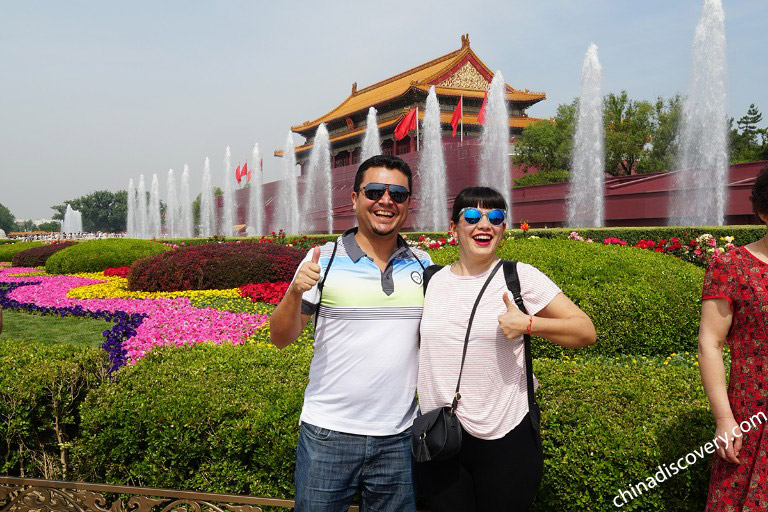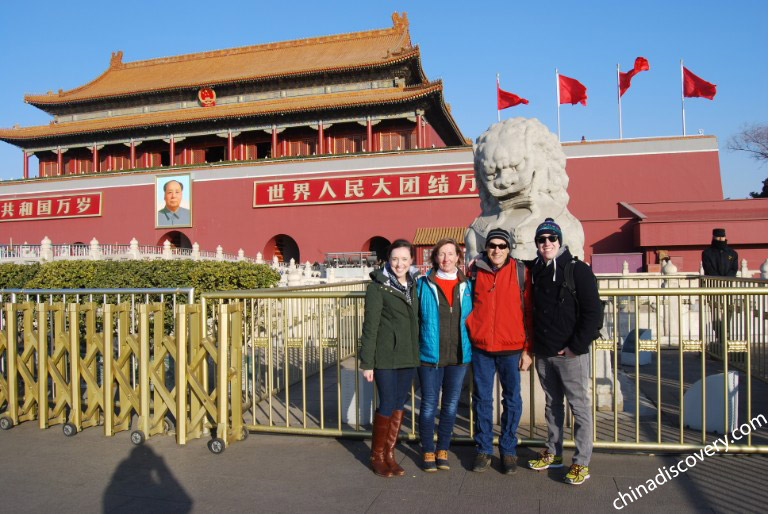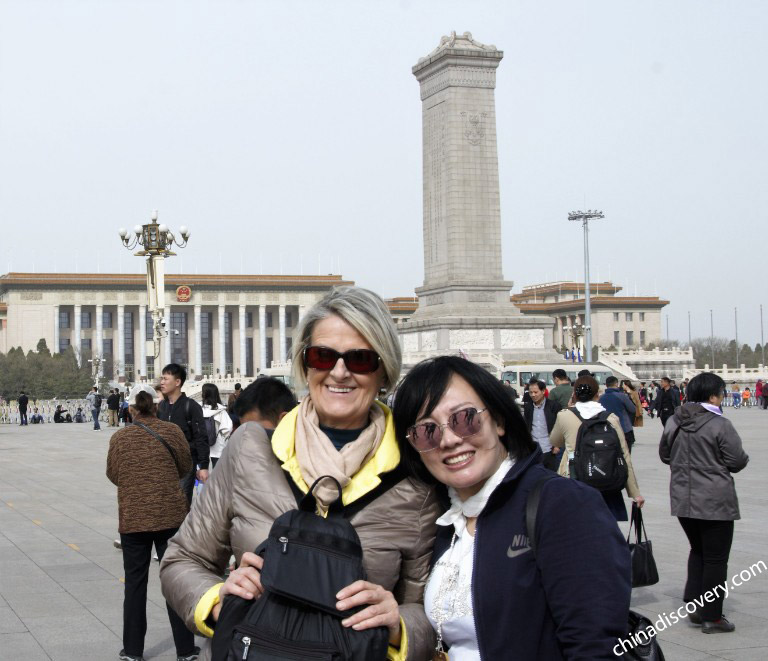Tiananmen Square (天安门广场) was first built in Ming Dynasty when Emperor Zhudi (朱棣) laid out the city of Beijing. It has been an imperial square enclosed by railings out the Forbidden Palace and civilians are forbidden to enter.
As more than 500 years passed, Tiananmen Square became a diamond in the crown of Beijing. It witnessed how Chinese people struggle against the feudal governance and foreign invaders for democracy and freedom. On 1st October 1949, Chairman Mao proclaimed the establishment of People’s Republic of China in Tiananmen Gate. Without any doubt, Tiananmen Square becomes a symbol of national cohesion and prosperity of China.
Occupying an area of 440,000 square meters and able to hold more than 1,000,000 people at the same time, Tiananmen Square stretches 880 m from north to south and 500 m from west to east. Monument to the People's Heroes is standing in the center of Tiananmen Square and Mao Zedong Memorial Hall is nearby. In northern Tiananmen Square is the ancient Tiananmen Tower which is constructed in 14 century while National Museum of China is in east square and Great Hall of the People west. Being magnificent and resplendent, the whole square presents a neatly symmetrical image.
Tiananmen Tower (under maintenance and not open to public at present) was first built in 1417 and acted as the front gate to Forbidden City. During Qing and Ming Dynasties, Tiananmen Tower was the place for officials and eunuchs to issue the emperor’s proclamation. It could be open only in major occasions such as emperors’ wedding, enthronement and ceremonies to worship heaven or earth.
The 33.7 meter high Tiananmen Tower is made up of the tower with 60 giant columns and below platform built in Sumeru throne. The tower is rather glorious, dazzling golden brick paving on the ground, two elegantly designed doors carved with delicate decorative pattern, the arch and beam drawn with Chinese traditional patterns with auspicious meaning. The front side of Tiananmen Tower has 5 arched doors, among which the mid one is exclusively open for the emperor in ancient times. Above this special door hangs a big portrait of Chairman Mao, and on its two sides you can read two sentence—one is “Long live the People’s Republic of China” while the other is “Long live the Unity of People of Whole World” Confronted with Tiananmen Square, Jinshui River flows by. Across Jinshui River builds some bridges for different people with different status.
With a height of 37.94 meter, Monument to the People’s Heroes is the largest monument in China’s history, also the first building after the founding of New China.
The monument is piled up by 17,000 pieces of granite and white marble. It includes platforms, sumeru thrones, body and head from bottom to top. The lower part of platform shapes like a crabapple flower, but the upper is quadrate and enclosed with white marble columns. The big sumeru throne above the platforms is inlaid with exquisite reliefs which depict the crucial events and showing a part of the centuries-old history of China. The front body of Monument to the People’s Heroes is faced with Tiananmen Tower and inscribed with large, glazed words by Mao Zedong (毛泽东): Immortal People's Heroes. The back part of the monument is composed of 7 pieces of stone with handwriting by Chairman Mao Zedong and inscribed by Premier Zhou Enlai (周恩来) which read “Glory forever”. The solemn and grandeur monument reflects the tremendous contribution of revolutionary martyrs and people’s strong homage to them.
Monument to the People’s Hero was designed by Liang Sicheng (梁思成) and other great architects after collecting the opinion of the influential person from construction zone, research zone and art zone. It is crystallization of culture and wisdom of people. In addition to paying respects to martyrs, Monument to the People’s Heroes still shows Chinese traditional national art, and acts as the essence of Chinese architectural art.
Step down from the white marble base at the rear of the Hall of Preserving Harmony, a wide courtyard separates the outer court from inner court.
Situated in the west side of Tiananmen Square, Great Hall of the people covers 170,000 square meters. This building involves the style of traditional Chinese architecture with the essence of western architectures. With 12 25-meter high marble gateposts standing in the frontage, the marble floor in peach-pink, translucent quartz lamp hanging on the roof, Great Hall of the People presents an atmosphere of refinement and elegancy.
In fact, Great Hall of the People is mostly used for ceremonial activities, national meeting or other special events like large anniversary celebration, memorial service for former leaders etc.
Mao Zedong Memorial Hall was built in 1977 to commemorate the founding leader Chairman Mao. It enjoys two floors. The first floor can be divided into three parts. In the Northern Hall, there is a lifelike white marble statue of Chairman Mao and an exquisite picture scroll of the beautiful lands in China. In the main hall, visitors can pay a view to the body of Chairman Mao. The great man lies in a crystal cabinet, draped in the flag of the Chinese Communist Party which is emblazoned with hammer and sickle. Chinese people show deep respect when faced with the physical presence of Chairman Mao. The Southern displays the literary achievements of the Chairman Mao. The second floor is equipped with 6 Revolutionary Performance Showroom of 6 great leaders including Mao Zedong, Zhou Enlai, Liu Shaoqi (刘少奇), Zhu De (朱德), Deng Xiaoping (邓小平) and Chen Yun (陈云). By large amounts of detailed and accurate photos, documents and other material objects, the showrooms give an expression to the historical picture of how Chinese people make a revolution and build a new China.
As a blend of collecting, displaying, research, archaeological studies, public education and cultural communication, National Museum of China is a comprehensive museum with an emphasis on Chinese art and history. It enjoys large scale, rich collections, and becomes one of the most popular museums in the world. Most charming collection is Ancient China Exhibition with 2026 cultural relics containing 521 fist level cultural relics. In the sequence of the changes of dynasties and focusing on cultural relics, the exhibition shows the endless stretches of Chinese civilization. The exhibition is made up of 8 parties according to different periods.
>> 4 Days Classic Beijing Tour Package
 Tiananmen Tower
Tiananmen Tower
 Inside Tiananmen Tower
Inside Tiananmen Tower
 Monument to the People's Heroes
Monument to the People's Heroes
 Reliefs in Monument
Reliefs in Monument
 Great Hall of the People
Great Hall of the People
 Mao Zedong Memorial Hall
Mao Zedong Memorial Hall
 Statue of Chairman Mao
Statue of Chairman Mao
 Treasure in National Museum of China
Treasure in National Museum of China
Passing through Tiananmen Square, the magnificent imperial palace coming into your eyes is charming Forbidden City. Once forbidden but now permitted. It will be an enjoyable experience to visit a huge palace once built by the Ming and Qing Dynasties. It is a huge palace complex of more than 9,000 rooms where 24 emperors of Ming and Qing Dynasties used to live in. Pass across various doorways to admire the magnificent and well preserved buildings decorated with yellow glazed tile roof, white marble base and splendid colorful paintings. The cultural richness of china is truly reflected at this historical palace.
 Forbidden City
Forbidden City
Tiananmen Square is at the city central axis of Beijing, just at the south of the Forbidden City. You can get there very conveniently by taxi, subway, bus, bicycle, and others. If you go by Beijing subway, you can take the Metro Line 1 to get off at Tiananmendong (天安门东) or Tiananmenxi (天安门西), or take the Metro Line 2 to get off at Qianmen (前门). And let’s see the distance to the hot attractions in Beijing as following.
| Attractions | Opening Hours | Admission Fee |
| Tiananmen Square | 08:30-16:30 | RMB 15 |
| Great Hall of the People | 09:00 - 14:00 (December 1-March 31) 08:15 - 15:00 (April 1 - June. 30) 07:30-16:00 (July 1 - August 31) 08:30-15:00 (September 1 - December 30) |
RMB 30 |
| Mao Zedong Memorial Hall | 08:00 - 12:00 (Tuesday & Sunday) 07:00 – 11:00 (July 1 – August 31) |
Free |
| National Museum of China | 9:00-17:00(Tuesday-Sunday) | Free |
Ticket fee is for reference only. For up-to-date information, feel free to contact us.
To explore the best highlights of Beijing, including Tiananmen Square, Forbidden City, Great Wall, Temple of Heaven, Summer Palace, Hutongs, you only need 2 or 3 full days, which is available for to 72 Hours Visa-free for Transit in Beijing. If you have more days, you can go for an in-depth Great Wall hiking or photography, and explore more hidden attractions in the city.
>> 4 Days Classic Beijing Tour Package
As the most popular transportation hub in China, you can easily travel from Beijing to any other hot travel destinations in China by flight or train, such as Xian, Shanghai, Yangtze River, Guilin, Chengdu, Tibet and other popular destinations in China by flight or train.. China Discovery has designed many great China tour packages from Beijing for you. Please make your choice from our collections or let us customize one for you.
Top 3 Beijing tours chosen by most customers to explore Beijing in the best way. Check the detailed itinerary, or tailor your own trip now with us.
Start planning your tailor-made holiday to China by contacting one of our specialists. Once inquired, you’ll get a response within 0.5~23.5 hours.
Customize a Trip